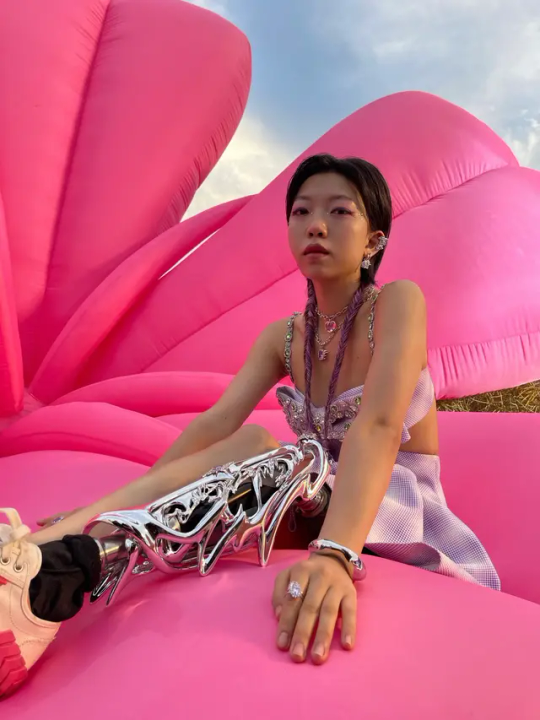Text
Raging against the machine: Cripplepunk and the “disabled and cute” movement
In 2015, a post on Tumblr appeared by user crpl-punk featuring a picture of the blog’s owner Tyler, dressed in attire of an alternative flair, a cigarette dangling out of their mouth and posing with their cane. The caption of the post read ‘cripple punk’, with Tyler stating that they were “starting a movement”, a statement that would prove to be true.


Tyler, the founder of the cripplepunk movement. The original image is featured on the left.
Tyler would later post more on their blog about their thoughts for the movement, wanting it to be a movement by and for disabled people to dispel against the “inspiration porn” status that many disabled people are relegated to. The movement promotes the agency of disabled people, urging the general public to see them as individuals and not just a “victim” of their disability, and to simultaneously acknowledge that their disability is part of who they are and call for more accessibility. While Tyler was a self-identified punk, the movement has gone beyond the punk aesthetic to encapsulate a wider political stance.
Cripplepunk would also go on to influence another disability based social media movement, “disabled and cute”. While still retaining a political edge, the movement also has a strong self-love stance. The #disabledandcute tag on Instagram boasts over 285,000 posts, with disabled folks displaying themselves and their look proudly. Jessica Kellgreen-Fozard, the woman behind Jessica Out Of The Closet and a deaf and disabled activist with an interest in vintage fashion, stated on her Youtube channel the following:
“People are going to look at you anyway, so you should give them something to look at.”


Jessica Kellgreen-Fozard of JessicaOutOfTheCloset
This quote encapsulates a lot of the ideology of the disabled and cute movement, with many posts to the hashtag showing people proudly displaying their love of fashion. Sprout, a v-tuber and artist (and a full-time wheelchair user) behind sproutwiki, creates illustrations of disabled characters based in fashion subcultures, highlighting his love of fashion.


Sprout's illustrations
I believe that these movements and the elevation of disabled voices can help create change to make us further included in our visibility in the fashion world. After all, we do like to look cool too :)
11 notes
·
View notes
Text
No longer invisible: Embracing mobility aids and prosthesis as a part of fashion
Prosthesis and other mobility aids have long been viewed as more of a “function-over-fashion” piece – an item that is needed to help disabled individuals in their everyday life rather than something that can be used to express oneself. These pieces are designed with the intention of not drawing attention to them, that disability is something to be kept invisible as not to inconvenience able-bodied people.
In 2021, the fashion world was greeted with a collaborative project between Chinese disabled influencer Xiao Yang and Chinese based accessories brand YVMIN, who had created a series of three prosthesis shells for Yang’s prosthetic leg. YVMIN’s aesthetic sensibilities are striking, making use of the “liquid metal” aesthetic to create unique and interesting pieces, often in a distinctive shining chrome look. In an interview with Vogue, Xiaoyu Zhang and Min Li – the design team behind YVMIN, described the project as a concept that would turn prosthesis into wearable art, Zhang stating that “We think it is only natural to decorate any part of our body, prosthetic as well.”
“This project tells everyone that wearing a prosthesis is a fact that cannot be changed—but wearing a prosthesis that looks gorgeous is also achievable.” – Xiao Yang


Photoshoot featuring Xiao Yang in her custom YVMIN prosthetic shells
Yang’s philosophy in regards to the use of prosthesis echoes the same sentiment many people in the disabled community have been saying for a number of years. In recent years, people have been embracing extending their own personal style into their mobility aids, taking the lead in decorating wheelchairs and canes to better fit their own style. Companies have also started to appear to offer stylish mobility aids, such as NeoWalk and their brightly coloured canes and Etsy sellers such as India-based ShivSilverJewels designing gorgeous ring splints for those with EDS and arthritis. With about 18% of the Australian population having some form of disability, we can hopefully look forward to seeing more brands and companies beginning to embrace aesthetic appeal in the creation of mobility aids for the community.
7 notes
·
View notes